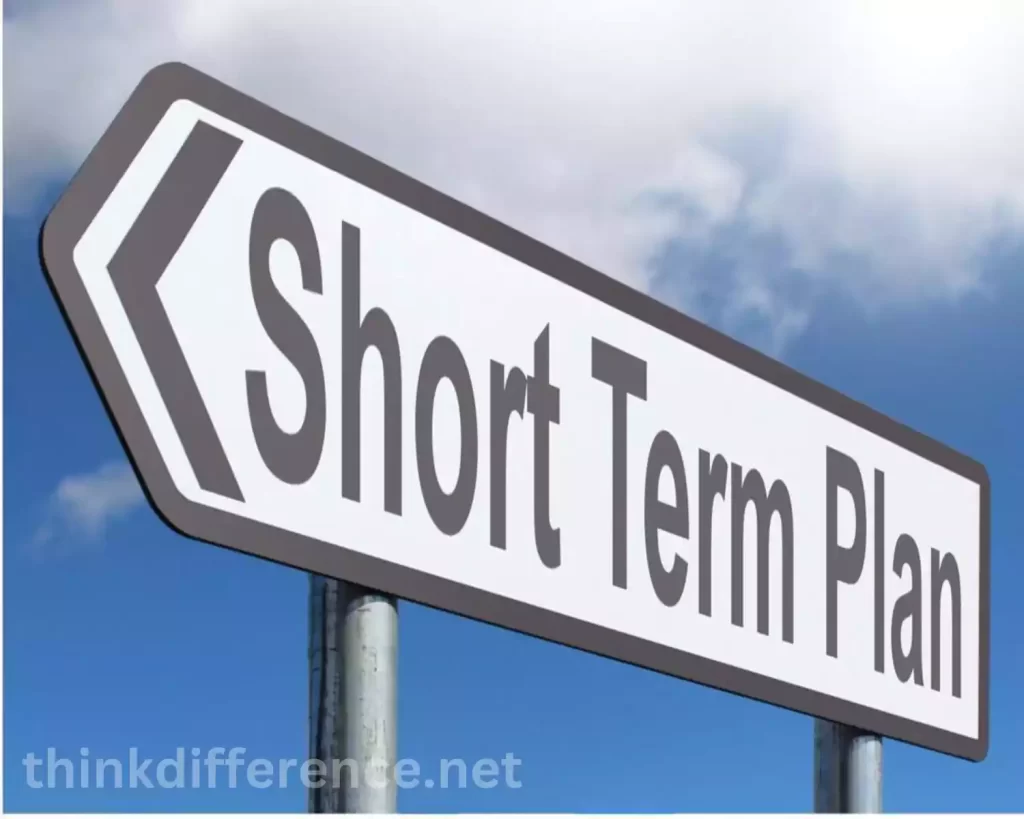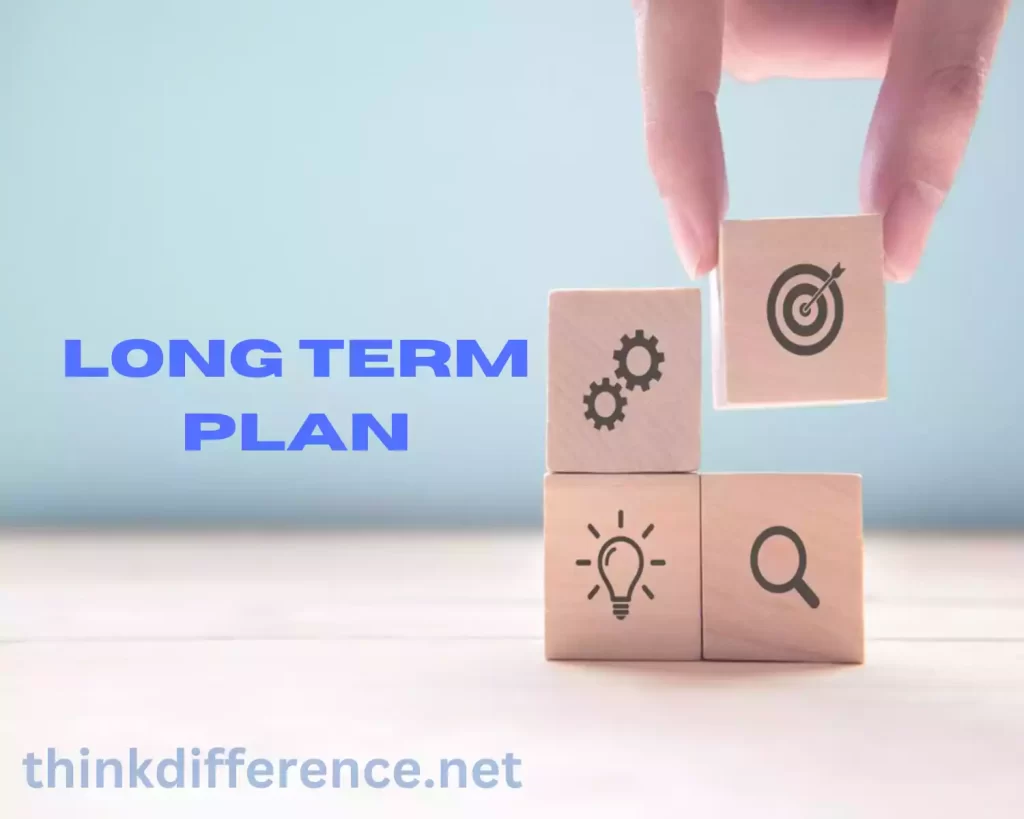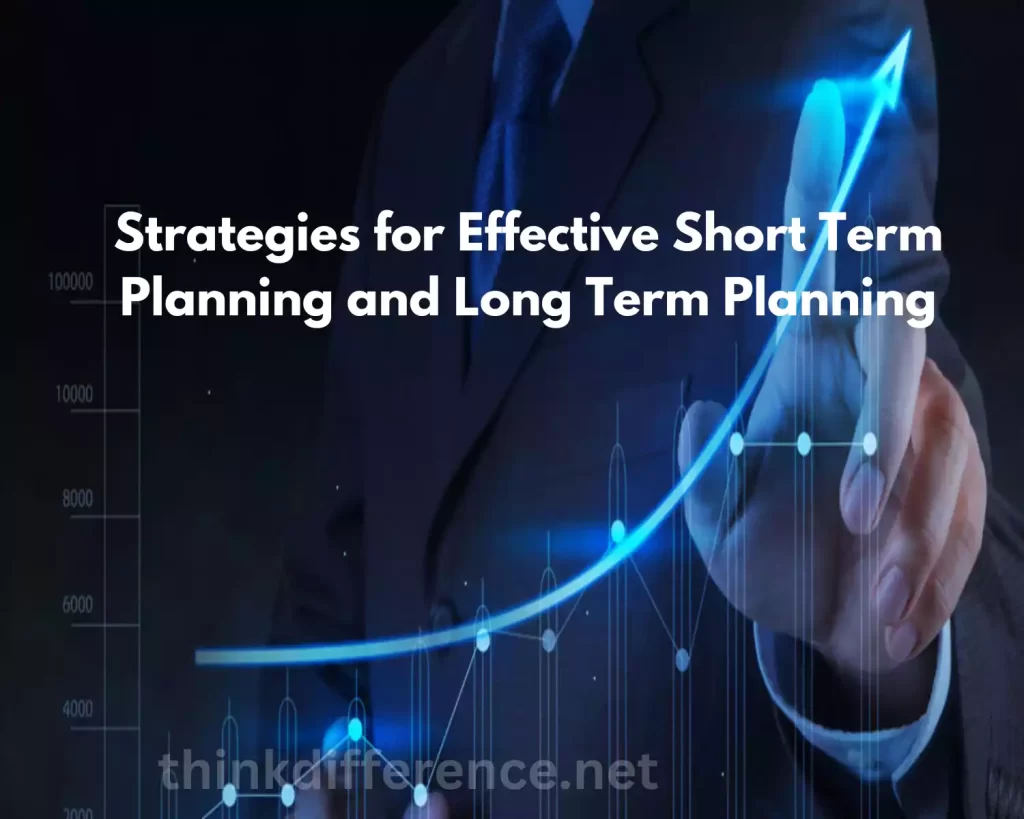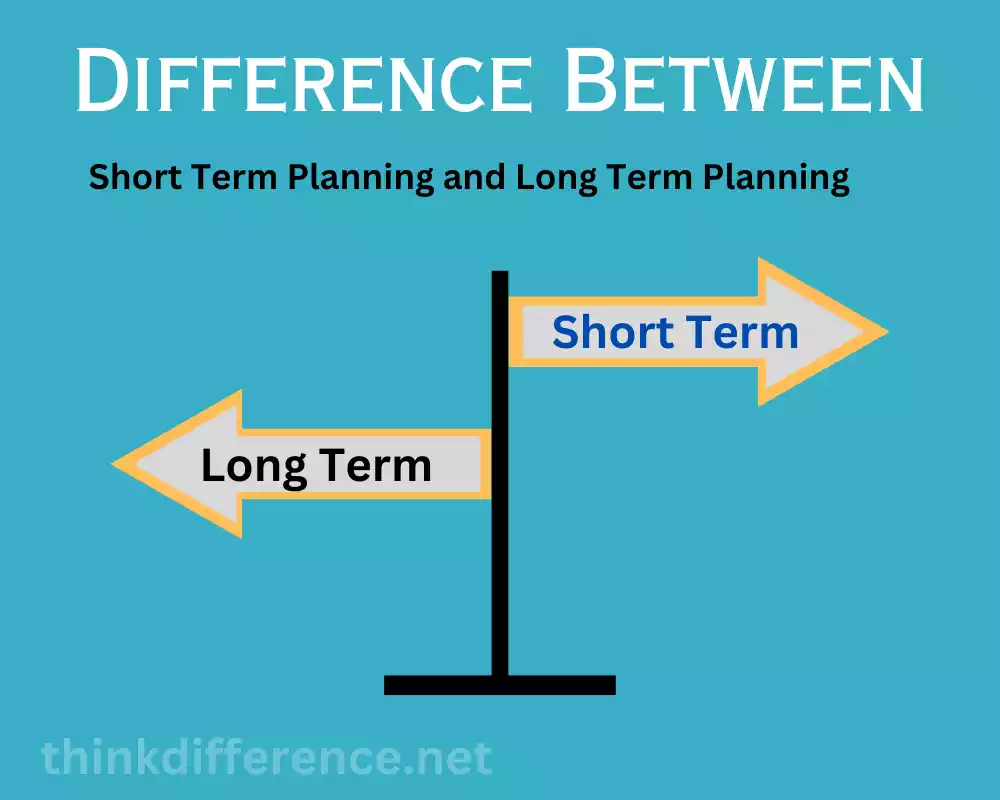Brief Overview of Short Term Planning and Long Term Planning
Short Term Planning:
Short-term planning involves devising and executing plans designed to reach near future or immediate goals within an allotted timeline, often within days or months. It focuses on optimizing daily priorities, tasks, activities which contribute towards overall success and progress as well as flexible resource allocation methods that respond quickly when circumstances change quickly.
Long Term Planning:
Long-term planning refers to the process of setting goals and creating strategies over an extended period, typically years or decades. Long-term planning provides a guiding vision that provides direction for growth and overall strategy; taking into account future trends, market conditions, internal/external influences to set ambitious and aspirational goals that help ensure informed decision-making and resource allocation for maximum effectiveness and growth.
Short-term planning typically encompasses immediate tasks and goals within a defined timeframe, while long-term planning sets forth an overall vision and direction to reach ambitious objectives over an extended period. Individuals, organizations and projects all must utilize both forms of planning to successfully reach their objectives.
What is Short Term Planning?
Short-term planning aims at reaching near or immediate goals and objectives through identification of actions, budget allocation and time allocation. Short-term plans typically last several weeks to months depending on context and nature of goals pursued.

Short-term planning processes are defined by their tactical and immediate nature, taking care to consider daily tasks that need to be accomplished to reach desired results. They take into account available resources as well as any short-range goals so as to facilitate smooth operations while meeting short-term objectives and responding quickly and appropriately to immediate threats or opportunities that arise.
Short-term planning may involve developing a weekly work schedule, outlining daily tasks, creating an advertising campaign to promote an event coming up quickly or setting sales targets within weeks. Short-term plans often focus on specific action steps needed to meet certain short-term objectives quickly; and these can often be easily revised when conditions or information changes or new information becomes available.
Short-term planning provides an organized way to manage immediate priorities, allocate resources efficiently and maintain focus on short-term objectives while contributing toward long-term goals for an individual, project or organization.
What is Long Term Planning?
Long-term planning refers to the practice of developing and executing, long-term strategies an extended period. This could last from years or decades and includes setting long-range objectives, outlining strategic directions and developing comprehensive plans in order to reach these objectives over this timeframe.
Long-term planning is an overarching, visionary strategy which looks forward to the desired future outcomes of an endeavor or organization, including analysis of trends and changes over time, forecasting new ones as they arise, visualizing aspirations over time as an organization or individual sets goals and plans accordingly, taking into consideration factors like market conditions, technological advances, competitive landscapes and social changes when devising its plan of attack.

Planning for the long term requires setting ambitious goals and identifying key initiatives, steps and investments necessary to attaining them. Long-term strategies involve allocating financial, human and technological resources in such a manner as to support long-term visions.
Long-term planning may consist of creating a five year strategic plan for business operations, an extended career development plan of several years duration or creating an urban masterplan over 20 years; or creating plans to save for retirement while taking into consideration long-term goals.
Plans for the long term tend to be less specific and detailed than their short-term counterparts, providing general directions with some flexibility and adaptability to changing circumstances. Regular reviews should also take place, to make sure long-term planning stays relevant with today’s realities, opportunities and challenges.
Long-term planning entails setting goals and devising strategies, in addition to making decisions with long-term implications on an organization or person. Long-term planning serves as an instrument of future success, growth and competitiveness.
Differences Between Short Term Planning and Long Term Planning
Time Frame:
- Short-Term Planning: Short-term planning involves setting short-term goals and objectives within an available timeline ranging from several days up to several months.
- Long-Term Planning: Long-term planning typically spans years or decades and includes setting long-term goals and strategies in order to reach them over this extended period.
Scope and Horizon:
- Short-Term Planning: In contrast with long-term planning, short-term planning usually has more of a focused goal involving tasks, activities or projects which need to be accomplished immediately in the short term.
- Long-Term Planning: Long-term planning encompasses more comprehensive considerations of objectives, strategic directions and future vision than short-term plans do, taking into account factors like market trends, industry shifts and long-range objectives to help form strategies and guide decisions.
Goals and Objectives:
- Short-Term Planning: Short-term planning typically deals with immediate goals and targets that relate to daily operations, short-range projects or goals that must be reached quickly.
- Long-Term Planning: Long-term planning refers to the practice of setting and attaining long-term goals and objectives that align with an individual, organization or project’s strategic vision. Long-term goals may encompass larger aspirations goals as well as outcomes that will be attained over a longer time span.
Flexibility and Adaptability:
- Short-Term Planning: Plans that span shorter time periods tend to be more adaptable and can easily adapt to shifting conditions, easily making revisions in response to unexpected events, new information or emerging opportunities and challenges.
- Long-Term Planning: Due to their longer timeline and wider focus, long-term plans tend to be less flexible. Although such planning often needs periodic adjustments and reviews for best results, long-term goals often remain on an achievable trajectory over time.
Detail and Specificity:
- Short-Term Planning: These plans tend to provide more specific, detailed instructions regarding actions, tasks and timelines necessary for meeting short-term goals.
- Long-Term Planning: Plans designed for the long term typically lack specificity and detail, providing more freedom to explore different paths towards reaching goals and explore different methods to reach them. They serve more as an outline or roadmap than being implemented step-by-step.
Learning the differences between short-term and long-term planning is vital to effective goal setting and resource allocation. While short-term plans typically focus on immediate needs such as operational efficiencies; long-term strategies focus on shaping sustainable growth plans with long-term visions of success and achievement. By integrating both forms of planning, you can both meet short-term targets while align them with long-term visions of sustainable success.
What is the Relationship Between Short Term Planning and Long Term Planning?
Both relationships are interdependent and complementary, helping individuals, organizations, and projects navigate successfully towards success. Here are some key aspects of their partnership:
- Align: Both short-term and long-term planning processes must be coordinated for optimal decision making and goal setting. Short term plans should derive their development from long-term visions and objectives and contribute towards realizing them; long-term planning serves as a framework that guides short-term actions taken towards their achievement.
- Strategic Direction: Long term planning establishes the direction and vision for an organization, project or individual by setting overarching goals that guide resource allocation and decision making. Short term plans translate this strategic direction into actionable steps and priorities; breaking long-term goals down into manageable pieces while providing an action plan aligning short-term actions with long-term vision.
- Progress Monitoring: Establishing short term objectives and deadlines are instrumental to tracking long-term goals effectively and maintaining accountability. Regular evaluation of performance allows regular evaluation and identification of areas needing adjustment – providing for timely course corrections based on timely monitoring feedback loop.
- Allocating Resources: Both short- and long-term planning play a vital role in allocating resources efficiently. Long-term planning provides tools that help allocate them according to long-term objectives and needs; short-term planning ensures resources are used efficiently both daily operations as well as short term projects while aligning them with strategies established during long-term planning.
- Adaptability: Long-term planning provides you with an image of the future; while short-term plans allow more nimbleness. Revisions or course corrections can more readily take place to accommodate new information or changing conditions more readily than with long-term plans; feedback from short-term plans can then be utilized to refine long-term ones to make sure they remain relevant and responsive.
Short term and long-term planning are interdependent processes; both provide invaluable benefits. Short term planning works to operationalize long-term visions, set immediate priorities and track progress while long term planning provides direction for short term goals and their contexts. By including both types of plans together in our approach we ensure an equitable approach with successful goal attainment and lasting success.
Benefits and Applications of Short Term Planning
Short term planning offers many advantages that can be applied across numerous scenarios and industries. By employing this technique, short term plans offer various benefits.
- Focus and Direction: Short-term plans provide structure and direction by outlining specific goals and objectives that must be completed within a relatively brief timeframe. They allow individuals and organizations to prioritize resources towards immediate priorities.
- Goal Achieved: Short-term planning can assist with setting and meeting more manageable, more attainable goals that contribute to overall business, project or personal success and progress. As goals are reached more rapidly it provides a sense of accomplishment and motivation as your achievements increase rapidly over time.
- Resource Allocation: Short-term planning helps allocate resources efficiently by considering immediate requirements and needs, allocating both money and personnel accordingly to support short-term goals and objectives.
- Adaptability: Short-term plans should be agile enough to adapt quickly as new opportunities or situations emerge, providing swift responses when new information or unexpected events come to light. This type of flexibility facilitates quick decision-making when information or events come our way that require quick reactions or decisions be taken quickly.
- Progress Monitoring and Evaluation: Short-term planning allows organizations and individuals to monitor progress towards goals, identify any challenges or areas for improvement and make any needed modifications so as to stay on course with their plans.
Short-term planning helps achieve goals, allocate resources efficiently, monitor results of benefits realization and promote adaptability across diverse domains (for instance project management).
Benefits and Applications of Long Term Planning
Long-term planning offers several advantages and can be utilized effectively across many contexts. Long-term planning provides multiple advantages.
- Strategic Vision: Long-Term Planning Can Create an Attainable Vision and Direction Long-term planning is essential in creating an obtainable vision and direction that are strategic for an individual, organization or project. A compelling long-range perspective should guide decision making, goal setting and resource allocation decisions as it ensures alignment among efforts towards attaining desired results and encourages focussed alignment on achieving them.
- Goal Setting and Accomplishment: Long-term planning facilitates goal setting by setting ambitious yet obtainable long-term objectives, breaking them into manageable steps or milestones that ensure progress is being made over a prolonged period of time. Planning long term helps sustain an overarching sense of purpose while making steady steps toward overarching goals.
- Resource Allocation Planning and Investment Planning: Long-term planning is used to allocate human, financial and other resources in an effective manner for long-term use, taking into consideration future priorities and needs as part of resource allocation decisions. Long-term plans help identify any gaps or areas requiring investment early by anticipating resource requirements in advance.
- Risk Management: Long-term planning can help identify and mitigate risks and challenges more effectively, providing opportunities to take proactive risk mitigation by considering future trends and market dynamics. Long term planning also serves to develop contingency plans and build resilience – essential tools when faced with unexpected events and uncertainties.
- Performance Tracking and Evaluating: Long-term planning provides an ideal platform for tracking progress towards long-range goals, with periodic evaluations to identify successes as well as areas needing adjustment. Organizations can make informed decisions by reviewing how their performance compares against this plan – helping improve effectiveness while keeping on course.
- Engagement of Stakeholders and Communication: Long-term planning is vital for engaging stakeholders and communicating strategic direction and vision effectively, including employees, partners and investors. Effective long-term planning enables goal setting strategies, progress reporting as well as creating an uplifting sense of purpose among employees, partners and investors.
- Decision-making Framework: Long-term planning provides a framework for making decisions that takes into account the long-term ramifications of actions and choices taken today, helping prioritize initiatives while evaluating tradeoffs; making informed choices to support long-range goals; and helping avoid short-sighted choices and stay aligned with strategic visions.
Long-term planning gives individuals and organizations alike a roadmap towards success, growth and resilience. Proactive decision making, goal attainment and resource allocation all play key roles. By aligning long-range goals to the realities of today’s dynamic environment, planning provides individuals and organizations alike a roadmap towards long-term goals with confidence and ability.
Strategies for Effective Short Term Planning and Long Term Planning
Here are some strategies that will help you plan both short-term and long-term goals more efficiently:

Strategies for Effective Short Term Planning:
- Define Short-term Goals: Set specific and SMART (specific, measurable, achieveable, relevant and time bound) short-term goals that align with your long-term vision, providing clear direction for short-term planning.
- Prioritize and focus: Determine which activities that have an immediate high-impact must be completed quickly in a short amount of time, prioritize according to urgency and importance, and direct resources and efforts accordingly.
- Break Down Short-term Goals into Doable Activities: Breaking your short-term goals down into smaller and more easily accomplishable activities and tasks can make accomplishing them much simpler. Establishing specific steps and time frames will make this easier to complete.
- Allocation of Resources: It is crucial that when creating a short-term plan, all necessary financial, human, and material resources are identified for effective implementation of its goals and objectives. Allocating these assets effectively ensures successful achievement.
- Monitor progress: Establish milestones and checkpoints to measure short-term goal progress against plans, identify any needed adjustments and measure any milestones reached with accurate metrics/indicators measurements as well as pinpoint areas that need special focus.
- Adaptability and flexibility: Be open and willing to change; be willing to adjust short-term plans as necessary, adopt an adaptive and agile mindset in response to unexpected events or opportunities that arise within short time spans, etc.
Strategies for Effective Long Term Planning:
- Create a Clear Vision: Set forth clearly your expectations of where you wish to head in terms of project, individual or organizational growth and achieve. Be sure that this vision is inspiring yet practical for attaining desired goals and is in keeping with its values and purposes.
- Conduct a Thorough Analysis: Collect all relevant data, investigate market trends, competitor insights and any external or internal influences which could compromise long-term planning efforts. SWOT analyses may help to uncover any challenges or opportunities present within an analysis process.
- Goal setting should be ambitious but realistic: Set long-term, obtainable objectives which reflect your vision and aspirations, with targets or milestones set as necessary to maintain momentum and keep track of progress.
- Formulate Strategies and Action Plans: Establish strategic and action plans outlining key initiatives, projects and steps necessary for reaching long-term goals. Set timelines, responsibilities and resources needed for each action taken.
- Engage Stakeholders: Make sure that all relevant stakeholders are engaged in the planning process, solicit their opinions and feedback as you make plans, ensuring their interests and perspectives are taken into consideration in your plans.
- Monitor and Reevaluate: Review progress made towards long-term plans on an ongoing basis, periodically evaluating them to see if they remain applicable, effective and in line with changing circumstances. Adjustments or refinements may be needed as necessary to keep your plan on track.
- Foster a Culture of Learning: Promote an environment which supports constant improvement and learning, promote innovation through feedback, knowledge-sharing and experimentation and foster an atmosphere in which employees feel safe to express themselves openly and make improvements over time.
These strategies can assist individuals and organisations to increase the efficiency and effectiveness of short-term and long-term planning processes, as well as ensure progress toward reaching desired objectives.
Conclusion
Short term planning and Long term planning are complementary approaches that empower individuals and organizations to navigate the path to success. By setting achievable short term goals and aligning them with long term visions, we create a roadmap that brings clarity, motivation, and a sense of purpose. Embracing the synergy of planning allows us to maximize our potential and achieve remarkable results.



